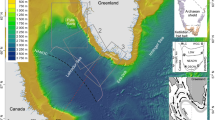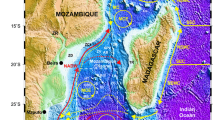Abstract
Since the recognition of current-produced bedforms in the deep ocean, attempts have been made to predict direction, intensity and variability of abyssal flow from the nature of sea floor irregularities (see refs 1–3). Longitudinal triangular ripples (LTRs) are inter mediate-scale bedforms (<20 cm high, metres long) that are becoming recognized as important and geographically widespread predictors of bottom-current flow. I describe here recent sea floor photographs of LTR fields on the lower continental rise off Nova Scotia which show that the bedforms develop in fine-grained, cohesive sediment with an alignment parallel to the regional contours and to mean current direction. An observational model for LTR formation is proposed, wherein LTRs are deposited initially as ‘tails’ behind large sea floor biological mounds and are subsequently constructed and propagate in the direction of mean current by sediment transport oblique to the bedform axis. This transport is induced by short-term currents that deviate from mean current direction and cause formation of a separation bubble on one side or the other of the LTR crest.
Similar content being viewed by others
References
Hersey, J. B. (ed.) Deep-Sea Photography (John Hopkins Press, Baltimore, 1967).
Heezen, B. C., Hollister, C. D. & Ruddiman, W. F. Science 152, 502–508 (1966).
Tucholke, B. E., Wright, W. R. & Hollister, C. D. Deep-Sea Res. 20, 973–997 (1973).
Hollister, C. D., Southard, J. B., Flood, R. D. & Lonsdale, P. F. in The Benthic Boundary Layer (ed. McCave, I. N.) 183–204 (Plenum, New York, 1976).
Zimmerman, H. B. J. geophys. Res. 76, 5865–5876 (1971).
Hollister, C. D., Flood, R. D., Johnson, D. A., Lonsdale, P. & Southard, J. B. Geology 2, 395–400 (1974).
Flood, R. D. Mar. Geol. 39, M13–M20 (1981).
Ewing, M. & Mouzo, F. Proc. natn. Acad. Sci. U.S.A. 61, 787–793 (1968).
Hollister, C. D., McCave, I. N., Laine, E. P., Lonsdale, P. F. & Richardson, M. J. Deep-Sea Res. (submitted).
Heezen, B. C. & Hollister, C. D. Mar. Geol. 1, 141–74 (1964).
Hollister, C. D., Nowell, A. R. M. & Smith, J. D. 3rd A. Rep. High Energy Benthic Boundary Layer Experiment (Woods Hole Oceanographic Institution Ref. 80-32, 1980).
Thorndike, E. M. Deep-Sea Res. 5, 234–237 (1959).
Le Pichon, X., Auzende, J. M., Pautot, G., Monti, S. & Francheteau, J. Nature 230, 110–111 (1971).
Richardson, M. J., Wimbush, M. & Mayer, L. A. Science 213, 887–888 (1981).
Allen, J. R. L. Current Ripples, Their Relation to Patterns of Water and Sediment Motion (North-Holland, Amsterdam, 1968).
Tucholke, B. E., Hollister, C. D., Biscaye, P. E. & Gardner, W. D. EOS 61, 1014 (1980).
Author information
Authors and Affiliations
Rights and permissions
About this article
Cite this article
Tucholke, B. Origin of longitudinal triangular ripples on the Nova Scotian continental rise. Nature 296, 735–737 (1982). https://doi.org/10.1038/296735a0
Received:
Accepted:
Issue Date:
DOI: https://doi.org/10.1038/296735a0
- Springer Nature Limited
This article is cited by
-
Boundary current-controlled turbidite deposition: A sedimentation model for the Southern Nares Abyssal Plain, Western North Atlantic
Geo-Marine Letters (1986)
-
Sedimentation under deep-sea storms
Nature (1984)
-
Deep Western Boundary Undercurrent delineated by sediment texture at base of North American continental rise
Geo-Marine Letters (1983)





